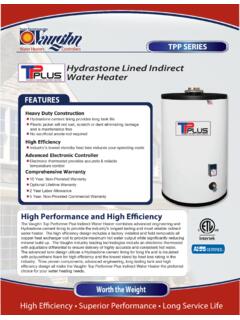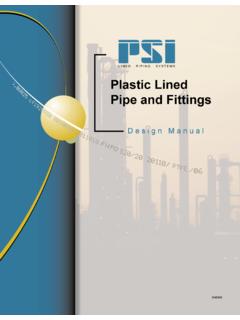Transcription of Engineering Guide - CORR TECH
1 Engineering GuideMaterial Descriptions .. 2-4 Industrial Standards .. 5-12 Relative Properties .. 13-14 Systems Engineering for Thermoplastic piping .. 15-35 Above-Ground Installation .. 36-37 Below-Ground Installation .. 38-39 Hydrostatic Pressure Testing .. 40 Installation of Thermoplastics .. 41-42 Solvent Cementing .. 43-47 Threading .. 48-49 Flanged Joints .. 50-51 Conversion Charts .. 52-58 Glossary of piping Terms .. 59-61 2002 Corr Tech, IncIndex 2002 Corr Tech, Inc2 POLYVINYLSPVC (POLYVINYL CHLORIDE) is, by far, the most commonplastic material used for plastic pipe. Its basic properties arechemical inertness, corrosion and weather resistance, highstrength to weight ratio, electrical and thermal service temperature is 140 F.
2 PVC has been usedsuccessfully for 40 years in such areas as chemicalprocessing, industrial plating, chilled water distribution,deionized water, and chemical drainage. Care should betaken to avoid using with Ketones, ChlorinatedHydrocarbons, and Aromatic Solvents. Joining methods aresolvent welding, threading (Schedule 80 only), or (CHLORINATED POLYVINYL CHLORIDE) isparticularly useful for handling corrosive fluids attemperatures up to 210 F. In chemical resistance, it iscomparable to PVC. It weighs about one-sixth as much ascopper, will not sustain combustion (self-extinguishing), andhas low thermal conductivity. Suggested uses includeprocess piping for hot, corrosive liquids, hot and cold waterlines in office buildings and residences; and similarapplications above the temperature range of PVC.
3 CPVC pipe may be joined by solvent welding, threading, (HOMOPOLYMER) is the lightestthermoplastic piping material, yet it has considerablestrength, outstanding chemical resistance, and may be usedat temperatures up to 180 F in drainage is an excellent material for laboratory andindustrial drainage piping where mixtures of acids, bases,and solvents are involved. It has found wide application inthe petroleum industry where its resistance to sulfur-bearingcompounds is particularly useful in salt water disposal line,chill water loops, and demineralized water. Joining methodsare coil fusion and socket heat POLYPROPYLENE is a copolymer ofpropylene and polybutylene. It is made of high molecularweight copolymer polypropylene and possesses excellentdielectric and insulating properties because of its structureas a nonpolar hydrocarbon polymer.
4 It combines highchemical resistance with toughness and strength atoperating temperatures from freezing to 200 F. It hasexcellent abrasion resistance and good elasticity, and isjoined by butt and socket Generally described in threeclassifications according to the relative degree ofbranching (side chain formation) in their molecularstructures and Density Polyethylene (LDPE) has more extensivebranching resulting in less compact molecularstructures and lower mechanical strength, than otherPolyethylenes. Good for temperatures to 140 F and isMATERIAL DESCRIPTION frequently used for food handling equipment, brinetanks and dispensing equipment. It may be hot gaswelded if Density Polyethylene (HDPE) has minimalbranching, which makes it more rigid and lesspermeable than LDPE.
5 Good for temperatures to160 F and is frequently used for abrasion resistantpiping, caustic storage tanks, and control tubing. Itmay be hot gas High Density Polyethylene (XLPE) is athree dimensional Polymer of extremely high molecularweight with individual molecular chains bondedtogether using heat plus chemicals or radiation. Thisstructure provides superior environmental stress-crackresistance and extremely high impact strength. Cross-linked Polyethylene becomes a thermoset materialafter manufacturing and cannot be hot gas for temperatures to 160 F with most commonuses including large tanks for outdoor Polyethylene have excellent chemical resistance toa wide range of common chemicals.
6 Avoid strongoxidizing agents and (POLYVINYLIDENE FLUORIDE) is a strong, tough,and abrasion-resistant fluoroplastic material. It resistsdistortion and retains most of its strength to 280 F. As wellas being ideally suited to handle wet and dry chlorine,bromine, and other halogens, it also withstands most acids,bases, and organic solvents. PVDF is not recommended forstrong caustics. It is most widely recognized as the materialof choice for high purity piping such as deionized is joined by thermal butt, socket, or (ECTFE) ETHYLENE CHLOROTRIFLUOROETHYLENE) is a durable copolymer of ethylene andchlorofluoroethylene with excellent resistance to a widevariety of strong acids, chlorine, solvents, and aqueouscaustics.
7 Halar has excellent abrasion resistance, electricproperties, low permeability, temperature capabilities fromcryogenic to 340 F, and radiation resistance. Halar hasexcellent application for high purity hydrogen peroxide and isjoined by thermal butt (POLYTETRAFLUORETHYLENE)There are three members of the PTFE family of fluoropolymer offers the most unique and usefulcharacteristics of all plastic materials. Productsmade from this resin handle liquids or gases up to 500 unique properties of this resin prohibit extrusion orinjection molding by conventional methods. When meltedPTFE does not flow like other thermoplastics and it must beshaped initially by techniques similar to powder PTFE is an opaque white material.
8 Once sinteredit is machined to the desired part. 2002 Corr Tech, Inc3 FEP (FLUORINATED ETHYLENE PROPYLENE) wasalso invented by DuPont and became a commercialproduct in 1960. FEP is a true thermoplastic that can bemelt-extruded and fabricated by conventional allows for more flexibility in manufacturing. Thedielectric properties and chemical resistance are similar toPTFE, but the temperature limits are -65 F to a maximumof 300 F. FEP has a glossy surface and is transparent inthin sections. It eventually becomes translucent asthickness increases. FEP is the mostly transparent and iswidely used for its high ultraviolet light transmitting (PERFLUOROALKOXY) is similar to PTFE and has excellent melt-processability and properties rivalingor exceeding those of PTFE.
9 PFA permits conventionalthermoplastic molding and extrusion processing at highrates and also has higher mechanical strength at elevatedtemperatures to 500 F. Premium grade PFA offers superiorstress and crack resistance with good flex-life in tubing. It isgenerally not as permeable as (TEFZEL , ETHYLENE TETRAFLUORO-ETHYLENE) Tefzel combines the mechanical toughnesswith outstanding chemical resistance that approachesPTFE. Effective from -20 F to 300 F, Tefzel is known for itsprocessability and high energy radiation (ACRYLONITRILE-BUTADIENE-STYRENE)Identif ies a broad family of Engineering thermoplastics witha range of performance characteristics. The copolymericsystem can be blended to yield the optimum balance ofproperties suited to a selected end use.
10 Acrylonitrileimparts chemical resistance and rigidity. Butadiene endowsthe product with impact strength and toughness, whileStyrene contributes to ease of (PPS) POLYPHENYLENE SULFIDE PPSexhibits outstanding high temperature stability, inherentflame resistance and good chemical resistance. Becauseof its high crystallinity and dimensional stability, PPS isused extensively for molded pump and valve few chemicals react with PPS, even attemperatures up to 200 F. PPS is compatible with suchhostile environments as esters, ketones, alcohols, basesand POLYMERSP olysulfone is a tough, clear thermoplastic used incorrosive environments. It has a temperature range to300 F.





